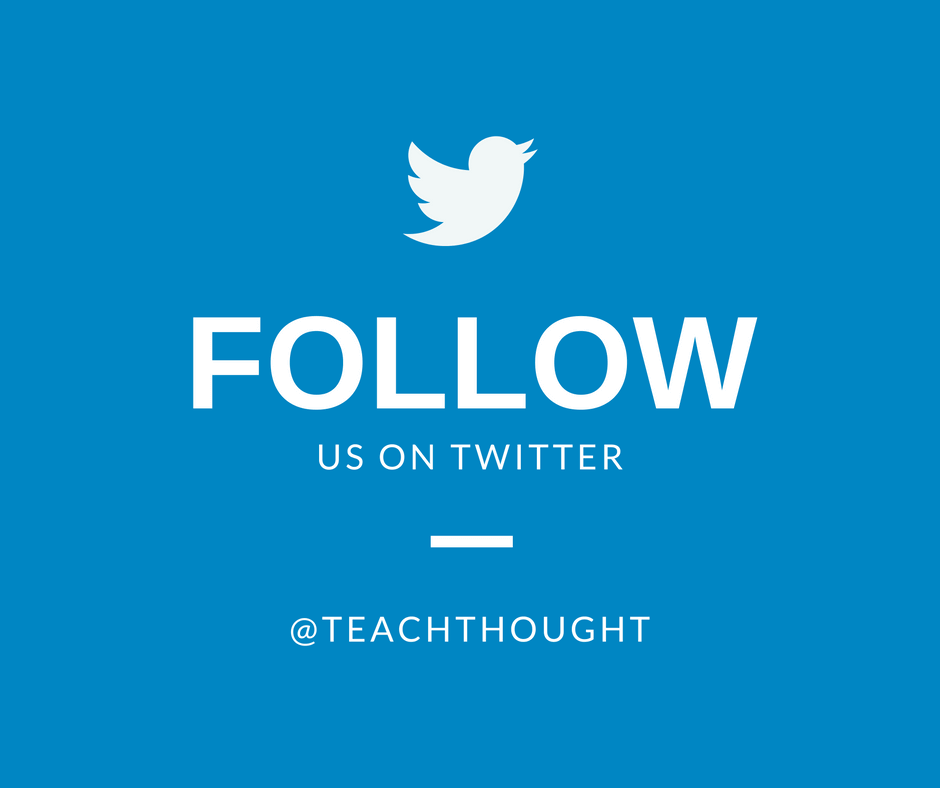Twitter Chats: An Example And Definition For Teachers
by TeachThought Staff
What’s a twitter chat? Where can you see an example of one? How do they work, exactly? All good questions.
Today, social media is undergoing changes in trend and usage–more visual and focused on engagement rather than simple funneling of traffic to websites, for example. The social media channels now stand on their own.
To wit, twitter isn’t exactly a new platform and teachers in particular have enjoyed its resource-giving potential for years. That means most TeachThought readers have likely seen plenty examples of twitter chats and know exactly what it is.
But maybe you don’t If that’s the case, let’s talk about it.
See also The Honest-To-Goodness Beginner’s Guide To Twitter For Teachers In 10 Steps
What’s A Twitter Chat?
In the broadest sense, a twitter chat is conversation on a specific topic held on twitter. But of course it’s more complicated than that.
Below, we’ll take a look at an example of a twitter chat. For now, let’s look at its characteristics.
1. A twitter chat is a twitter-based twitter public discussions based on a specific topic. Generally, there are pre-written questions that act as prompts. These are tweeted using a hashtag so participants can follow the chat/discussion and participate if they wish.
2. Twitter chats are generally held ‘live.’ This means that people wanting to ‘chat’ ‘meet’ at a specific time and respond to questions from a twitter chat host. (More on that below.)
3. Because of how twitter works, some method of ‘unifying’ the conversation needs to be used. Without this, the chat will be lost in a stream of other tweets by other people you follow.
4. To accomplish this, a #hashtag is used. Participants can then search for the hashtag and view the entire conversation in one single stream, and append their own tweets with the given hashtag in order to have their contributions join the chat/conversation.
Note, sometimes the #hashtag used is general enough to be used by twitter users that have no interest in or awareness of the conversation being held. For example, if the chat is on mobile learning and the hashtag #mobilelearning is used, someone may tweet and use the #mobilelearning hashtag completely unaware of the chat being held.
At times, this adds to the conversation, as the ongoing use of the hashtag allows for new ideas and resources to be discovered. At others, it allows for irrelevant tweets (that are skipped over easily enough by readers, of course) to be unwittingly included in the conversation.
5. Speaking of ongoing use, another great part about twitter chats is that they don’t have to stop, but can continue indefinitely.
While the formal question-and-answer portion usually ends at a pre-determined time, users can access the ‘chat’ at anytime by searching for the specific #hashtag used in the chat. Between formal twitter chat gatherings and set times, users can continue to use the hashtag to join the conversation.
(In fact, it could be argued that this is the ideal use of hashtags–persistent and ongoing–rather than the more formal meet-and-answer-questions-for-an-hour approach.)
How Does A Twitter Chat Work?
So now you know what a twitter chat is and how it works in a general sense, what about the specific formatting during the live conversation? Seeing an example of one will be useful.
Besides the aforementioned use of specific hashtags, the only other thing you need to know really is how to ‘answer’ questions. Though it can vary from chat to chat, usually one person (the moderator/host) has a series of questions they create beforehand.
When the twitter chat begins at the pre-determined time, the host will introduce the topic and themselves and any other key participants. Next, they’ll simply tweet a question/prompt intended to promote discussion and response from twitter chat participants. They’ll prepend all questions with the letter ‘Q’ and a number indicating which question in sequence it is.
For example, in a twitter chat on critical thinking, we might start like this:
“Good evening! Thanks for everyone joining the #criticalthinking twitter chat tonight. Let’s get straight to the chat!
Q1. How do you define critical thinking in your classroom? #criticalthinking’
Participants would then answer by prepending their responses with the letter ‘A’ followed by the number matching the question they’re responding to–something like this if they were answering the question above:
‘A1. We define critical thinking as any thinking intended to evaluate and judge a subject.’
The host usually moves on to the second question (Q2) after a pre-determined period of time (for example, two minutes) or when they feel there has either been enough time for everyone to respond (which could be more or fewer than two minutes).
The above process is continued until all of the questions have been covered. To end the twitter chat, the host usually thanks the participants, then lets them know where they can find the chat (if they use a tool like storify to embed it), when the next chat is scheduled for, and points them to any other relevant links or resources for further reading or engagement.
An Example Of A Twitter Chat
Below, we’ve embedded below for reference so you can see an actual example of a twitter chat so the above is embedded in an authentic context that you’d actually see.
